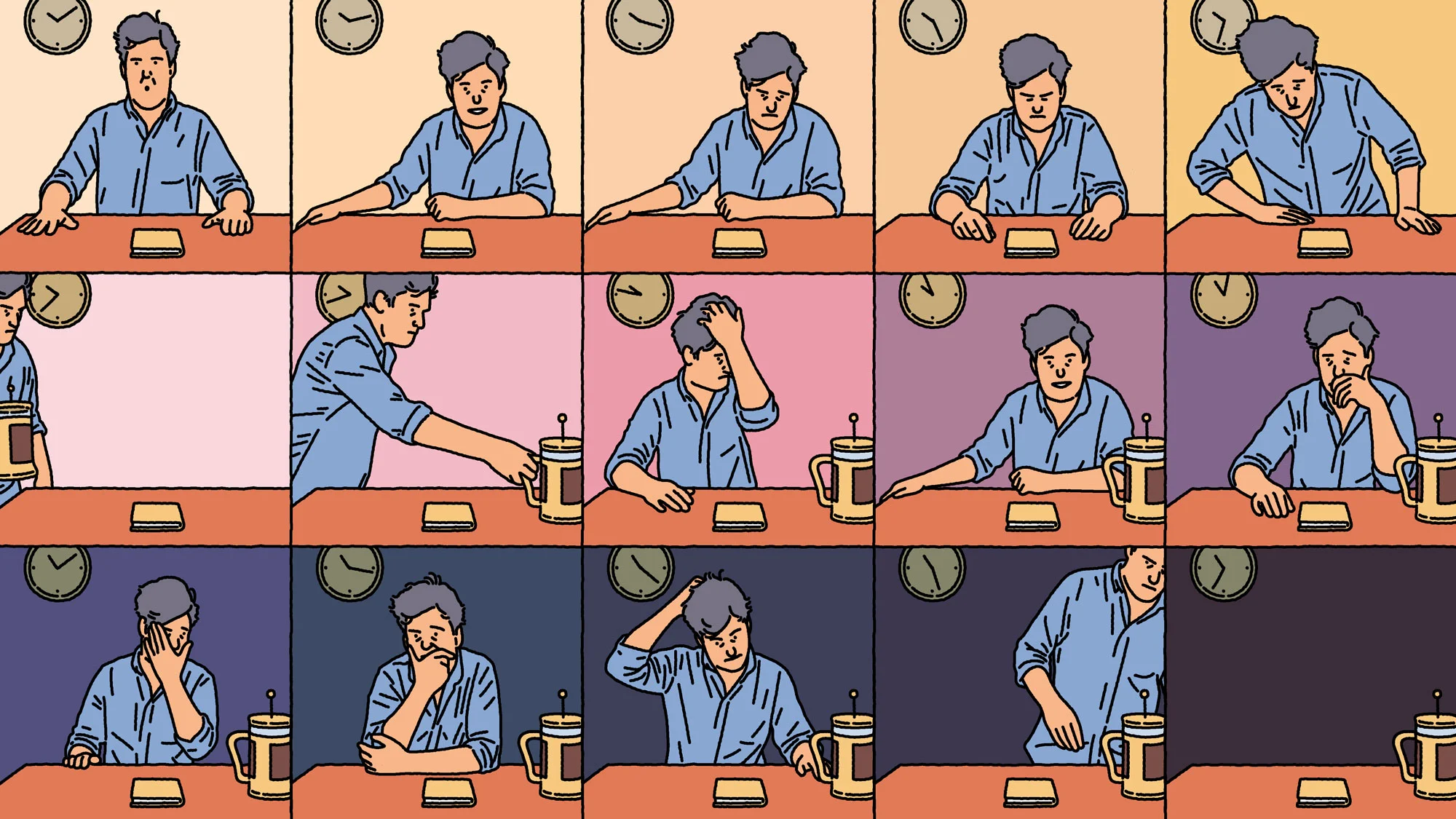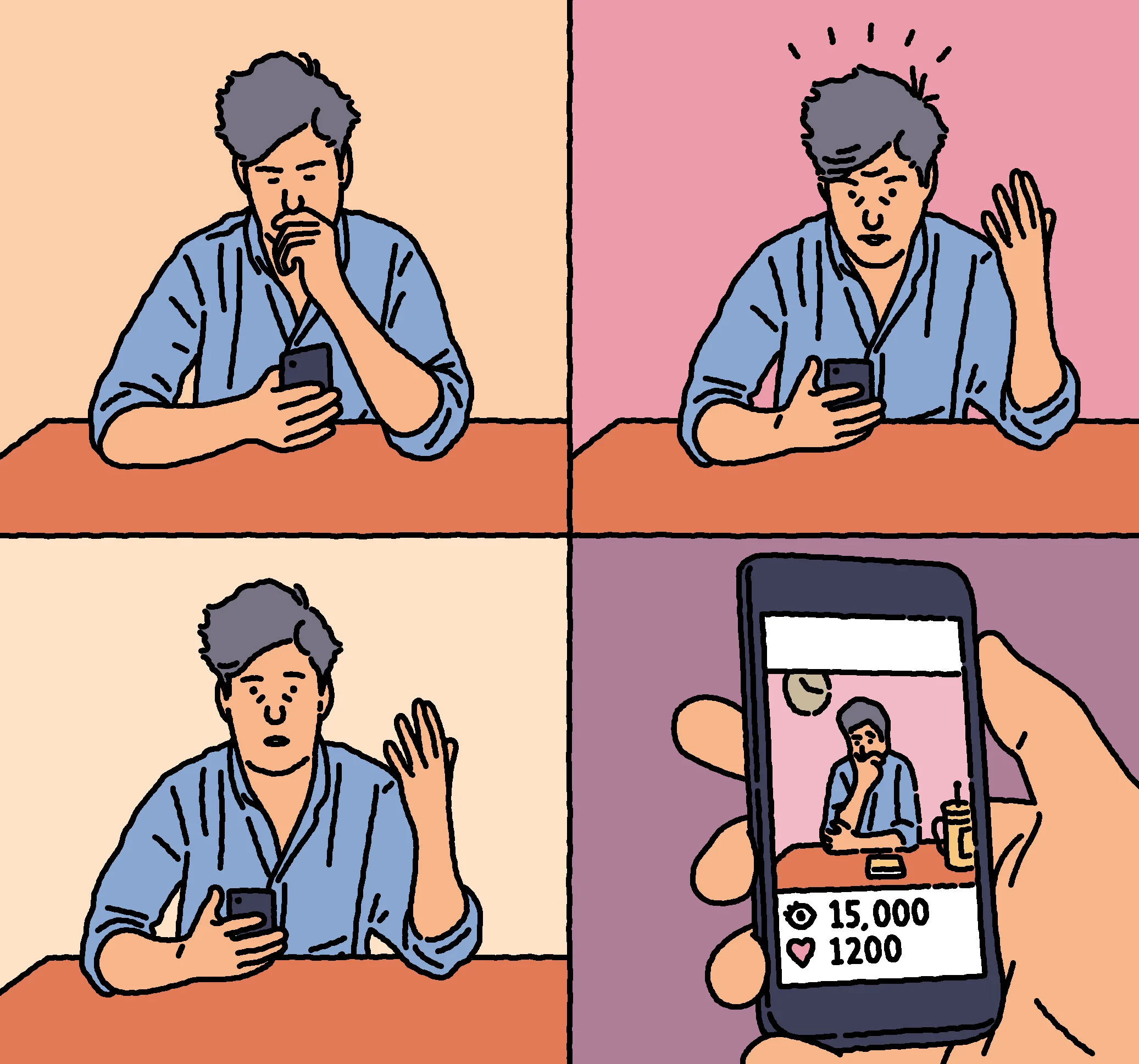

The rules of social media are constantly rewritten, with the latest set prioritizing short-form video over static imagery. This is good news for camera-ready Instagram influencers and TikTok comedians, but bad news for illustrators like Jim Stoten, who have long relied on platforms like Instagram to promote their work and themselves. Having recently dipped his toe into the world of “nothing films” and Reels, Stoten considers the point of posting when the algorithm has stacked the odds against you.
Illustrations by Jim Stoten.
If you’d told me 20 years ago that a computer would one day decide my work was unfit to be seen simply because it did not move, and that this development would induce my 42-year-old self to panic, I would probably have looked at you as if there was something wrong with you, and pitied your bizarrely limited vision of the future. It doesn’t sound like the sort of thing that could instill fear in a person—but when it actually happened to me, it certainly did.
When I opened Instagram on Monday, July 25, 2022, things looked a bit different, and I turned to Google to find out why. It turned out Instagram had rolled out a new user interface and implemented a crucial change to its algorithm, prioritizing short-form video content, or Reels, over static imagery in my own feed, and everyone else’s.
This made me nervous. I do not—or did not at that time—make moving images. I made drawings and collages, and a bit of music sometimes, too. But not moving images. I wondered how someone like me, a lone human being who relied quite heavily on Instagram as a tool for self-promotion, would fare against this machine that had the power to relegate my work to irrelevance.
Something inside of me insisted on soldiering on, despite this new development. I naively thought there was no way Instagram would punish the millions of users who promoted their motionless artwork on its platform, and had done so for years. But as the number of likes and comments on my posts began to dwindle, a vision of a bleak future without any new work opportunities took form in my mind.
Over the next few days, Instagram rubbed salt into my wounds, showing me endless Reels of people playing pranks, lip-syncing Jim Carrey bits, riding bikes into lamp posts, and gleefully pestering their pets until they retaliated with violence. All the while, I was finishing a drawing of a horse, and wondering how to make it stand out against this tidal wave of video.
Luckily, I was on holiday when it happened, so I had a bit of time to think about it properly. I was also working on a commissioned short film for the Eames Institute of Infinite Curiosity in California. The brief was completely open, and I was trying to decide what to make my film about, while walking in the sun, looking at art, and drinking more than I normally would.

How could I speak about creativity when, to me, creativity just didn’t feel like it used to?
By the time I got home, Instagram was unrecognizable—just like TikTok, people explained. Having never used TikTok before, I decided to download the app and quickly confirmed for myself that, yes, Instagram was now exactly the same as TikTok. I also couldn’t help noticing that both Instagram and TikTok were almost exactly the same as the home videos show “You’ve Been Framed!”—the only differences being that the clips were shorter, and most people weren’t getting paid for submitting them.
I decided to focus on the film I was supposed to make. I’d determined it would be about creativity and the importance of experimentation in my daily practice. I set up a camera in my studio to film myself talking to it, but as soon as I pressed the button to record, I felt like anything I had to say about creativity was meaningless and irrelevant. How could I speak about creativity when, to me, creativity just didn’t feel like it used to? I ended up filming myself for just sitting there, thinking of something to say, for a good couple of hours.
At first, I couldn’t bring myself to watch the footage. And when I eventually did manage to, during the edit, I found it difficult to watch. I was watching myself silently tell myself the work I make doesn’t matter anymore. I also found this footage quite funny for the exact same reason. I decided to edit it into Reel-length clips and post them on Instagram. After all, these were moving images—these were what the algorithm wanted. It wasn’t a protest. It wasn’t even a complaint. It was a document of what happens to a person who is uncomfortable with change, when things change.
Their performance baffled me, though it really shouldn’t have. My “nothing films,” as I came to call them (in an effort to make this all seem intentional), got a lot of views—not exactly viral numbers, but more than anything I had posted for a while. I also received a lot of messages from followers telling me they hadn’t seen anything I had made in their feeds for months. This angered me, so I edited together more films of me doing nothing and posted them too. The algorithm has no way to judge the quality or entertainment factor of a video; it just knows it’s a video.
For a little while, I was excited that I had found a way to cheat the system, and to remain a part of the club of users whose posts are actually seen. But of course, at some point, I had to go back to making drawings and other “boring” static images, which, when posted or shared, quickly knocked me back to square one. It took about a week of not posting anything before I started to reminisce about the heady days of posting my nothing films and garnering engagement from the void.
The algorithm has no way to judge the quality or entertainment factor of a video; it just knows it’s a video.
I’m left trying to ignore a troubling question. If I know that what I make doesn’t really have much chance of being seen anymore, then what is the point of making it? And I know the answer is the same as it has always been, because the problem is the same as it has always been.
I know I will always make things, no matter what, because making things is so much fun. Getting other people to take an interest in the things I make has always been the hardest part of the job for me.
I used to take comfort from the story of the artist Henry Darger, whose enormous and fascinating body of work was only discovered after his death, hidden in his two-bedroom Chicago apartment. His work is now revered as perhaps the finest example of outsider art that has ever been created. “So maybe promoting myself and my work isn’t that important,” I used to think. But that only works if you’re ok with the idea of never receiving any recognition as an artist while you’re alive. (I’m not.)
When I first discovered Instagram, I was able to promote my work in a way that felt interesting, enjoyable, curated, and professional. It’s so easy to share work for commercial projects alongside work that comes out of personal projects. And then there’s the feedback element. Although it can be dangerous to take too much notice of likes, follows, and comments, they can provide a pleasant boost for a person who has dared to show something they’ve made to the world.
So for illustrators and other creative people who don’t make moving images, seeking out effective methods of self-promotion has become a problematic question once again. It’s just a slightly more annoying problematic question now, because for a little while there, we had an answer.

